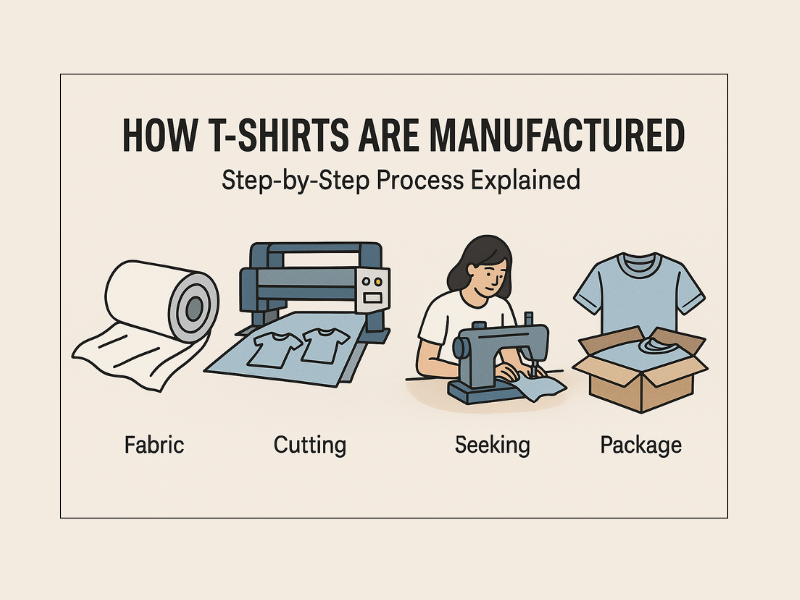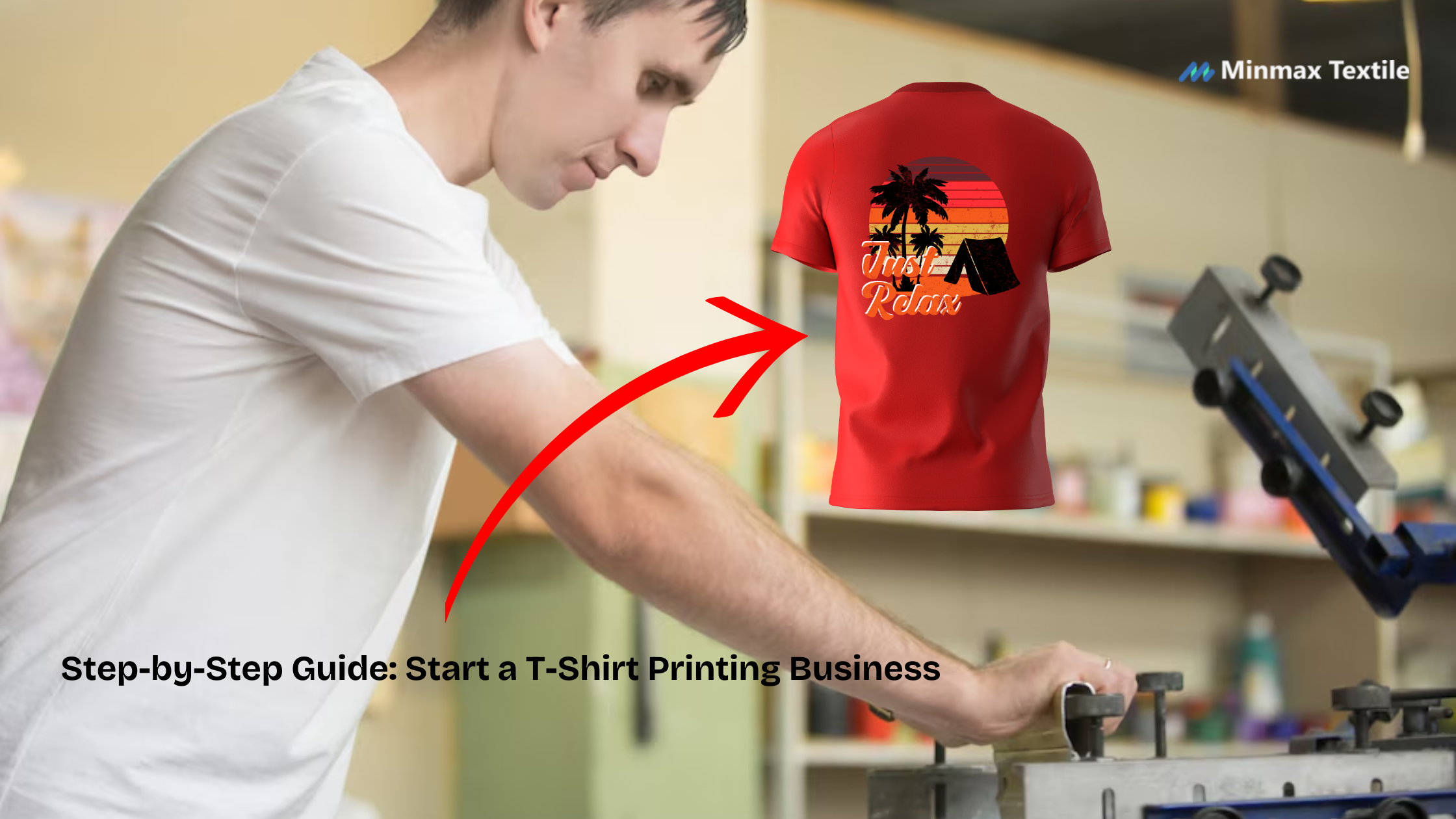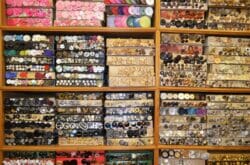T-shirts are a staple in wardrobes around the globe, loved for their comfort and versatility. But have you ever wondered how are t shirts manufactured? The journey from raw materials to the shirt you wear involves multiple stages, each critical to the final product’s quality and sustainability. In this article, we’ll explore the fascinating process of how are t shirts manufactured, diving deep into each step to give you a comprehensive understanding. Whether you’re a fashion enthusiast, a business owner, or just curious, this write up will enlighten you on the intricate art of T-shirt manufacturing.

How are t shirts manufactured
T-shirt manufacturing involves several key steps to transform raw materials into the finished product. Here’s an overview of the process:
Raw Materials: The Foundation of T-Shirts
The first step in the topic how are T shirts manufactured is choosing the right materials. The fabric forms the backbone of any T-shirt, affecting its comfort, durability, and overall feel. Let’s take a closer look at the primary materials used in making T-shirts.
1.Cotton: The Primary Fabric
Cotton is the most popular fabric for T-shirts, known for its softness, breathability, and versatility. But not all cotton is created equal. Here’s a breakdown of the types of cotton commonly used in T-shirt manufacturing:
- Regular Cotton: Widely used and affordable, regular cotton is soft and breathable, but may shrink and wrinkle.
- Combed Cotton: This cotton undergoes a process to remove short fibers and impurities, resulting in a stronger, smoother fabric.
- Ring-Spun Cotton: Even softer and more durable, ring-spun cotton is made by continuously twisting and thinning the cotton strands.
- Organic Cotton: Grown without synthetic pesticides or fertilizers, organic cotton is an eco-friendly choice that supports sustainable farming practices.
Why Cotton?
- Comfort: Cotton fibers are soft and breathable, making them ideal for everyday wear.
- Durability: High-quality cotton is strong and can withstand repeated washing.
- Versatility: Cotton can be dyed easily, allowing for a wide range of colors and designs.
Fun Fact: Did you know that it takes about 2,700 liters of water to produce the cotton needed for a single T-shirt? This highlights the importance of sustainable cotton farming practices.
2.Synthetic Fabrics: Alternatives to Cotton
While cotton reigns supreme in the T-shirt world, synthetic fabrics offer some compelling advantages. Let’s explore some popular alternatives:
- Polyester: Durable and resistant to shrinking and wrinkles, polyester is often blended with cotton to enhance the fabric’s properties.
- Rayon: Known for its silk-like feel, rayon drapes well and is often used in lightweight, flowy T-shirts.
- Blends: Combining natural and synthetic fibers, blends offer the best of both worlds. For example, a cotton-polyester blend combines the softness of cotton with the durability of polyester.
Advantages of Synthetic Fabrics
- Durability: Synthetic fabrics like polyester are extremely durable and resistant to wear and tear.
- Moisture-Wicking: Many synthetic fabrics wick moisture away from the body, keeping you cool and dry.
- Affordability: Synthetic materials are often more affordable than natural fibers.
Quick Tip: When shopping for T-shirts, check the label for fabric composition. Blended fabrics can offer a perfect balance of comfort and durability.
The Design and Pattern Making Process
Designing a T-shirt is like creating a piece of art. It’s about expressing an idea in a way that connects with people on a personal level. The journey from raw materials to a finished T-shirt involves a crucial step: design and pattern making. This stage is where creativity meets precision, transforming ideas into tangible patterns and prototypes that guide the rest of the manufacturing process.
1.Conceptualizing the Design
Every great T-shirt starts with an idea. This stage involves brainstorming and conceptualizing designs that resonate with the target audience. Fashion designers play a pivotal role here, using their expertise to blend aesthetics with functionality.
Steps in Conceptualizing a T-Shirt Design:
- Trend Analysis: Designers keep a close eye on current fashion trends, consumer preferences, and seasonal themes to ensure their designs are relevant.
- Sketching: Initial ideas are sketched out, often using digital tools like Adobe Illustrator or traditional methods.
- Color Selection: Choosing the right colors is crucial. Designers consider color psychology and trends to select hues that will appeal to the target market.
- Fabric Selection: The choice of fabric affects the design. Designers choose fabrics that complement their vision, considering texture, weight, and drape.
2.Creating Patterns and Prototypes
Once the design concept is finalized, the next step is pattern making. This involves creating a blueprint that guides the cutting and sewing process.
Digital vs. Manual Pattern Making:
- Digital Pattern Making: Modern pattern making often involves software like CAD (Computer-Aided Design), which allows for precise and easily modifiable patterns. This method is efficient and reduces errors.
- Manual Pattern Making: Traditional pattern making involves creating patterns by hand on paper or cardboard. While time-consuming, it allows for a tactile understanding of the design.
Steps in Pattern Making:
- Measurement: Accurate measurements are crucial. This includes chest, waist, sleeve length, and overall length.
- Drafting: Using the measurements, patterns are drafted for each part of the T-shirt (front, back, sleeves).
- Grading: Patterns are adjusted to create different sizes, ensuring consistency across various sizes.
- Prototyping: A sample T-shirt is made using the initial pattern to test the fit and design. Adjustments are made as needed.
Table: Comparison of Digital and Manual Pattern Making
|
Aspect |
Digital Pattern Making |
Manual Pattern Making |
|
Accuracy |
High, with precise adjustments |
Variable, dependent on skill |
|
Efficiency |
Fast, easy modifications |
Time-consuming |
|
Flexibility |
Highly flexible, easy to store and share |
Limited, physical storage needed |
|
Cost |
High initial cost (software) |
Lower initial cost |
??Importance of Prototypes: Prototyping allows designers to see their designs in real life, making it easier to spot and correct issues before mass production. It’s a critical step to ensure the final product meets expectations.
3.Fabric Cutting: Precision and Efficiency
The fabric cutting stage is where the patterns come to life. This process requires precision and efficiency to minimize waste and ensure the quality of the final product. Let’s take a closer look at the techniques and technologies used in fabric cutting.
Laying Out the Fabric
Before cutting begins, the fabric must be laid out properly. This step is crucial for ensuring that patterns align correctly and fabric waste is minimized.
Techniques for Efficient Fabric Layout:
- Single-Ply Layout: Each layer of fabric is laid out individually. This method is time-consuming but ensures high accuracy.
- Multi-Ply Layout: Multiple layers of fabric are stacked and cut simultaneously. This is more efficient for large-scale production but requires precise alignment.
- Marker Making: Markers are templates that show the placement of pattern pieces on the fabric. They help in maximizing fabric usage and reducing waste.
Tips for Minimizing Fabric Waste:
- Optimize Marker Layout: Use software to create the most efficient marker layout.
- Consider Fabric Grain: Align patterns with the fabric grain to ensure durability and proper drape.
- Reuse Scraps: Small scraps can be used for smaller pattern pieces or recycled.
Cutting Techniques
Once the fabric is laid out, the cutting process begins. This can be done manually or using automated machines.
Manual Cutting:
- Scissors: Used for small-scale production or intricate cuts.
- Rotary Cutters: Provide clean, straight cuts and are easier to use than scissors.
Automated Cutting:
- Laser Cutting: Uses a laser to cut fabric with high precision. It’s ideal for complex patterns and ensures consistent quality.
- Die Cutting: Uses a die (a specialized tool) to cut fabric into specific shapes. It’s efficient for repetitive patterns.
- CNC Cutting Machines: Computer-controlled machines that cut fabric according to digital patterns. They offer high precision and efficiency.
Advantages of Automated Cutting:
- Precision: Automated machines provide consistent and accurate cuts.
- Efficiency: Faster than manual cutting, suitable for large-scale production.
- Versatility: Capable of cutting complex shapes and multiple layers.
Table: Manual vs. Automated Cutting
|
Aspect |
Manual Cutting |
Automated Cutting |
|
Accuracy |
Variable, dependent on skill |
High, consistent |
|
Speed |
Slower, labor-intensive |
Fast, efficient |
|
Cost |
Lower initial cost |
Higher initial cost (machines) |
|
Complexity |
Limited to simpler patterns | Handles complex patterns |
??
Fun Fact: Automated cutting machines can cut through up to 100 layers of fabric simultaneously, significantly speeding up the production process!
4.Sewing: Bringing the T-Shirt Together
Sewing is where the cut fabric pieces are assembled into a finished T-shirt. A well-sewn T-shirt is like a well-made meal. Every detail matters, from the ingredients to the technique. This stage involves various techniques and machines to ensure durability and comfort.
Assembly Line Sewing
In large-scale production, sewing is typically done on an assembly line, with each worker specializing in a specific part of the T-shirt.
Step-by-Step Sewing Process:
- Shoulder Seams: The front and back pieces are sewn together at the shoulders.
- Neckband: The neckband is attached, often using a rib-knit fabric for elasticity.
- Sleeves: Sleeves are sewn onto the armholes.
- Side Seams: The front and back are sewn together along the sides.
- Hemming: The bottom hem and sleeve hems are sewn to finish the edges.
Common Stitches and Seams:
- Overlock Stitch: Used for seams, it prevents fraying and provides a clean finish.
- Coverstitch: Used for hemming, it creates a durable and stretchy seam.
- Flatlock Stitch: Used for sportswear, it creates a smooth seam that lies flat against the skin.
Quality Control in Sewing
Ensuring the quality of stitching is crucial for the durability and appearance of the T-shirt.
Inspection Processes:
- Visual Inspection: Checking for straight seams, even stitching, and proper alignment.
- Tensile Testing: Ensuring seams can withstand stress without breaking.
- Defect Tracking: Recording and analyzing defects to improve future production.
Common Issues and Solutions:
- Skipped Stitches: Often caused by improper needle and thread selection. Solution: Use the correct needle and thread for the fabric type.
- Puckering: Caused by tension issues or mismatched fabric. Solution: Adjust tension settings and use appropriate fabric.
5.Printing and Embellishments: Adding Style
The next stage in T-shirt manufacturing is adding designs and embellishments. This is where creativity shines, turning a plain T-shirt into a unique piece of clothing.
Screen Printing
Screen printing is one of the most popular methods for adding designs to T-shirts. It’s known for its vibrant colors and durability.
Process of Screen Printing:
- Design Preparation: A design is created and separated into different colors.
- Screen Creation: Screens (stencils) are made for each color in the design.
- Printing: Ink is applied through the screens onto the T-shirt. Each color is printed separately and allowed to dry.
- Curing: The printed T-shirt is heated to set the ink, ensuring durability.
Advantages of Screen Printing:
- Vibrant Colors: Can produce bright, bold colors.
- Durability: Designs withstand many washes without fading.
- Cost-Effective: Economical for large batches.
Direct-to-Garment (DTG) Printing
DTG printing uses inkjet technology to print designs directly onto the fabric. It’s ideal for complex designs and small batches.
Explanation of DTG Technology:
- Design Upload: The design is uploaded to a computer connected to the printer.
- Printing: The printer applies ink directly to the T-shirt, similar to a paper printer.
- Curing: The T-shirt is heated to set the ink.
Comparison with Screen Printing:
- Detail: DTG can print intricate designs with many colors.
- Setup: DTG has a simpler setup, making it ideal for small runs.
- Cost: More expensive per unit than screen printing for large batches.
Additional Embellishments
Beyond printing, there are several ways to add style to T-shirts.
Embroidery: Adds texture and dimension with stitched designs. Appliqu??: Uses fabric pieces sewn onto the T-shirt for a layered effect. Heat Transfers: Designs are printed on transfer paper and applied with heat.
Benefits of Embellishments:
- Unique Designs: Offer a way to create one-of-a-kind T-shirts.
- Textural Variety: Add interest and variety to plain T-shirts.
- Customization: Ideal for personalized or branded T-shirts.
6.Finishing Touches: Preparing for Market
The final steps in the topic how T shirts are?? manufactured involve finishing touches that ensure the product is ready for consumers.
Washing and Pre-Shrinking: Pre-shrinking fabric is essential to prevent size changes after washing.
Importance of Pre-Shrinking:
- Consistency: Ensures the T-shirt maintains its size and shape.
- Consumer Satisfaction: Reduces the risk of returns due to shrinkage.
Methods Used for Pre-Washing:
- Hot Wash: Fabric is washed in hot water to shrink it before cutting and sewing.
- Steam Treatment: Steam is used to relax fibers and set the fabric.
Ironing and Folding: Ironing ensures a crisp, professional finish, while folding prepares T-shirts for packaging.
Techniques for Ironing:
- Steam Ironing: Removes wrinkles and sets seams.
- Pressing: Used for areas like the neckband and hems to create sharp edges.
Efficient Folding Methods:
- Standard Fold: Common for retail display.
- Rolling: Used for compact packing, such as in bulk shipments.
Labeling and Packaging: Proper labeling and packaging enhance the brand and provide important information to consumers.
Importance of Branding and Care Labels:
- Brand Recognition: Labels help consumers identify the brand.
- Care Instructions: Provide washing and care information to ensure longevity.
Packaging Options:
- Plastic Bags: Protect T-shirts from dust and damage.
- Eco-Friendly Packaging: Uses recycled or biodegradable materials to reduce environmental impact.
Table: Types of Packaging
|
Type |
Advantages |
Disadvantages |
|
Plastic Bags |
Protects from dust and damage |
Not eco-friendly |
|
Cardboard Boxes |
Sturdy and protective |
Bulky and expensive |
|
Biodegradable Bags |
Environmentally friendly |
Higher cost |
|
Poly Mailers |
Lightweight and cost-effective |
Limited protection |
??
Fun Fact: Eco-friendly packaging can enhance brand image, attracting environmentally conscious consumers.
Sustainable and Ethical Manufacturing Practices
Sustainability and ethics are increasingly important in T-shirt manufacturing. Consumers are more aware of the impact their purchases have on the environment and workers’ rights.
1.Eco-Friendly Materials and Processes
Using sustainable materials and processes reduces the environmental footprint of T-shirt manufacturing.
Use of Organic Cotton and Recycled Materials:
- Organic Cotton: Grown without synthetic pesticides, reducing environmental harm.
- Recycled Materials: Reusing materials like polyester reduces waste and conserves resources.
Water and Energy Conservation Techniques:
- Low-Impact Dyes: Reduce water usage and pollution.
- Energy-Efficient Machines: Minimize energy consumption during production.
Quick Tip: Look for certifications like GOTS (Global Organic Textile Standard) and OEKO-TEX when choosing sustainable fabrics.
2.Ethical Labor Practices
Ensuring fair wages and safe working conditions is essential for ethical manufacturing.
Ensuring Fair Wages and Safe Working Conditions:
- Fair Trade: Certification ensures workers receive fair wages and work in safe conditions.
- Audits and Inspections: Regular checks help maintain ethical standards.
Certifications and Standards:
- Fair Trade Certified: Ensures fair wages and safe conditions.
- WRAP (Worldwide Responsible Accredited Production): Focuses on lawful, humane, and ethical manufacturing.
Final Words
From raw materials to the finished product, the journey of a T-shirt is complex and fascinating. Each step, from design and pattern making to sewing and embellishments, plays a critical role in creating the final product. Emphasizing quality and sustainability ensures that the T-shirts not only look good but also feel good to wear and support ethical practices.
By understanding how T shirts are manufactured, you gain a greater appreciation for this everyday garment. Next time you put on your favorite T-shirt, you’ll know the intricate process that brought it to life.
FAQs
1.How long does it take to manufacture a T-shirt?
The time to manufacture a T-shirt can vary based on the complexity of the design and the scale of production. Generally, it can take anywhere from a few hours for a single piece to several days for bulk orders.
2.What is the most common fabric used for T-shirts?
Cotton is the most common fabric used for T-shirts due to its softness, breathability, and versatility. Other popular materials include polyester, rayon, and blends of different fibers.
3.How can I ensure the quality of a T-shirt?
To ensure the quality of a T-shirt, look for factors like fabric type, stitching quality, and proper finishing. Checking reviews and purchasing from reputable brands can also help. Pay attention to details such as even seams, smooth prints, and sturdy hems.
4.What are the most sustainable practices in T-shirt manufacturing?
Sustainable practices include using organic cotton, recycled materials, water and energy conservation techniques, and ensuring fair wages and safe working conditions for workers. Certifications like GOTS and Fair Trade can indicate sustainable and ethical practices.
5.Why do some T-shirts shrink after washing?
T-shirts can shrink after washing due to the nature of the fabric fibers. Cotton, for example, can shrink if not pre-shrunk before manufacturing. To avoid shrinkage, follow care instructions, wash in cold water, and avoid high heat drying.
6.How can I identify a well-made T-shirt?
A well-made T-shirt will have consistent stitching, a soft feel, and no loose threads. Check the seams, hems, and neckband for even stitching and reinforcement. High-quality T-shirts often use combed or ring-spun cotton, which feels smoother and lasts longer.



